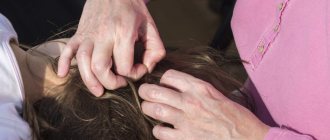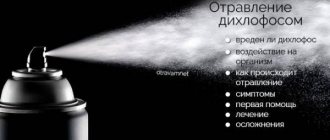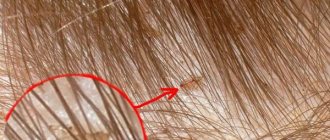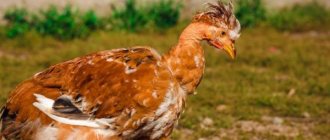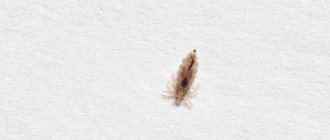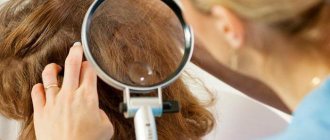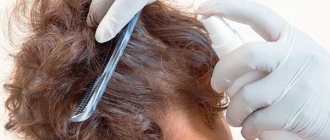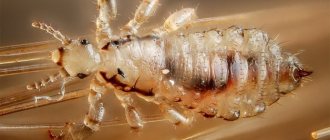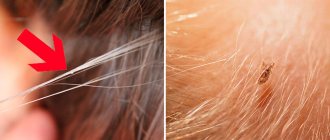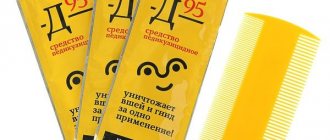Composition and properties of tar soap
Since pharmaceutical insecticides have a serious chemical effect, their use can provoke allergic reactions. Treating lice with tar soap is considered safer.
Its key components are alkali and birch tar.
The latter contains a lot of bioactive substances:
- organic acids.
- Phenols.
- Tannins.
- Esters of organic acids.
Since the composition is natural, the risk of adverse reactions is minimized.
Due to its properties, soap relieves inflammatory processes and has a disinfecting effect on the skin.
Operating principle
To judge whether lice can be removed using tar soap, you need to understand the principles of its action.
The destruction of parasites is due to the presence of active substances such as alkali and phenol derivatives. Their versatility allows you to stop infections of a bacterial, fungal and viral nature.
Please note: soap will not have an antiparasitic effect if you simply wash your hair with it. To get rid of lice, you need long-term contact of the lice with a detergent (at least half an hour). During this period, the active components of the soap penetrate the chitinous shell and have a detrimental effect on insects.
The presence of aromatic substances in the composition explains the specific aroma that repels parasites.
Disinsection of bedding
Treating Bedding Treating your bed is quite simple.
But this must be done in parallel with removing lice from the head. After completing all the necessary procedures for the treatment of pediculosis, the linen is processed. Destroy parasites using the thermal method. Processing bed linen begins with collecting it in a plastic bag so that on the way to the washing machine the louse does not fall on the carpet, interior items, or remain on the mattress.
Wash at a temperature of at least 60 degrees Celsius for at least 30 minutes. Upon completion of the procedure, it is recommended to dry the items naturally outside. Then iron thoroughly with a steam iron. Particular attention is paid to seams and folds.
On a note!
Head lice do not live in bedding, but they can stay for some time. Body lice crawl onto the human body only to get food; they spend most of their time on linen and in bed. In this case, washing and ironing bedding is the main procedure for combating linen lice.
The mattress should be additionally treated with an iron and steam. Or a household steam generator, if available.
Methods of application
The use of tar soap must be combined with the hair combing procedure. To do this you will need a special comb with fine teeth.
Here is the most common recipe for getting rid of parasites:
- Lather wet hair, lather well, rinse thoroughly. These manipulations will help degrease the skin.
- Apply the soap to your hair a second time and leave it in the open air for about 40 minutes (without wrapping it up). Wash off with warm water and regular shampoo.
- Comb wet hair with a comb, holding your head over a white sheet. This will ensure the effectiveness of the work done.
To consolidate the result, the procedure should be repeated daily for 7 days.
There are several options for using tar soap against lice.
As an independent remedy
You can use hair lice soap as a standalone remedy. Since its composition is natural, several procedures will be required to achieve the desired effect.
The step-by-step instructions are as follows:
- wash your hair with tar soap against lice (you can use a bar or liquid form).
- Re-soap your hair, after squeezing it lightly. It is necessary to distribute the foam as much as possible over the skin and over the entire length of each strand.
- Wrap your head in plastic or a special cap, then wrap it in a towel.
- Recommended exposure time is 30-60 minutes.
- After the specified period, wash your hair thoroughly and wrap it in a towel (do not blow-dry!).
After all the manipulations, slightly damp hair must be combed with a special comb. Fine teeth will help comb out dead lice.
In combination with an anti-pediculosis drug
For pediculosis, tar soap can be used in combination with pharmaceutical preparations. This combination of tools will allow you to achieve results in the shortest possible time.
In this case, the procedure is as follows:
- use a specialized product, following the instructions for use.
- Leave for the required time, then rinse off the product with warm water.
- Apply tar soap to your hair and lather well.
- Wrap your head with film and a towel, exposure period is 30-40 minutes.
- Wash off the foam. Use a comb to comb out lice.
With this treatment regimen, tar soap softens the effects of pharmaceutical insecticides.
How to make soap at home
It is possible to make tar soap yourself. The recipe for cooking at home is as follows:
- Take tar and baby soap without fragrances or dyes.
- Chop the soap on a fine grater.
- Create a water bath. Pour the prepared soap into the upper container and add 20 g of water, stirring until dissolved.
- Add 2 tbsp to the resulting mass. l. birch tar.
- Mix thoroughly, let cool to 38°C and pour into molds. You can use any cosmetic or medicine jars.
- Leave in air for 7 days.
You can make tar soap yourself at home.
The product is suitable for regular use and will be more gentle than store-bought ones.
The effectiveness of tar soap against lice
The use of soap against head lice is possible in combination with the following additives:
- essential oils (lavender, cloves). A couple of drops in a container with tar soap will eliminate the specific aroma and enhance the antiparasitic effect.
- Unrefined vegetable oil. Blocks the breathing of parasites using a special film. Facilitates the combing process and does not dry out the skin.
- Hellebore water. Moisten a cotton pad and apply to hair along the entire length, after rinsing off the soap suds. Wrap your head, leave for half an hour, then rinse with shampoo.
You can get rid of nits using acetic acid.
It dissolves the glue of parasites, as a result the larvae are easily combed out with a comb.
Although tar soap helps, it can hardly be called a panacea for lice. When used once, it is ineffective, especially if not supported by additional techniques. To achieve the desired result, you will have to use the substance more than once and follow the recommended exposure time.
Precautionary measures
Although tar has virtually no contraindications, caution must be exercised during therapy:
- Avoid use if you have allergies.
- If the skin is thin and dry, and the hair is brittle, then such soap can cause irritation, redness and deterioration of the hair condition.
- It is recommended to add a little castor or burdock oil to soap foam and use restorative balms.
- Apply externally only. If it gets inside, it will cause heartburn and abdominal pain.
- Make sure that soap suds do not get into your eyes.
Expert opinion
Sidorenko Veronika Leonidovna
Candidate of Medical Sciences, St. Petersburg Research Institute of Epidemiology and Microbiology named after Pasteur.
Before using lice soap on children and pregnant women, you should consult your doctor.
.
Contraindications
It is not advisable for women during gestation or breastfeeding to use tar soap as a treatment for head lice, especially without first consulting a specialist.
In addition to these, there are a number of other contraindications:
- tendency to allergic reactions. A small preliminary test will help identify likely side effects.
- Childhood. If a baby has lice, you should resort to pharmaceutical drugs. Their gentle composition and gentle effect will protect delicate skin from dryness and cracks.
- Increased sensitivity. Using tar soap against lice and nits can cause dryness, itching, and irritation.
At the stage of preparation for conceiving a child, it is also not recommended to get rid of lice using this technique.
From parasites
The effective use of tar soap in these situations is determined by its chemical composition, which contains many phenol compounds and alkalis.
Thanks to their combination, various viruses, bacteria, fungi, and small parasites are actively suppressed.
This is the reason why such soap copes with the prevention of various infections and inflammations that occur on the affected areas of the skin.
At high concentrations, these components help eliminate lice. At the same time, a number of rules should be followed in order for the soap to be useful in the fight against these parasites and to have the most powerful effect.
This means a long-term effect on lice, so therapy with a 5-minute application of it to the affected areas of the skin and hair will not get rid of the pests.
An important point is that lice eggs (nits), which they lay in the skin, are resistant to the effects of tar. After the first use of the product, which will destroy the main number of lice, the procedure should be repeated to remove newly formed parasites (after about 7-14 days).
For greater reliability, you should not limit yourself to two applications, as relapse may occur.
The use of soap with tar as a means of removing lice is a product of “folk art”. This comes from the fact that it has been used for skin conditions, helping to alleviate the effects of problems such as scratching, head lice, allergic reactions and inflammation.
As it turned out, while alleviating the sensations of patients, it prevented skin damage from re-infection, but had little effect on lice. Those. It effectively fought the effect, but not the cause.
An erroneous assumption played a significant role in recognizing it as a reliable, indispensable folk remedy in the fight against these parasites.
Review of tar soap
There is no need to deny the success of its use in conjunction with other means and medications for removing lice.
The use of soap for these purposes is common among those who support the use of natural means of struggle, who are afraid of the side effects of medications, calling them “harmful chemicals.”
After treatment with soap, mechanical action on the hair using combs is necessary. This will allow you to quickly remove lice, since after treatment with soap they will be inactive and weak.
In the absence of prejudice towards medications, soap with tar can be useful. By using it, you can significantly reduce the risks of various skin irritations, and if they exist, speed up recovery.
Soap allows you to effectively remove the remnants of used insecticides (sprays, shampoos, creams), often used as folk remedies, kerosene and vinegar.
Advantages and disadvantages
Tar soap acts as an antimicrobial agent, accelerating the healing process of small wounds on the scalp. This substance can be regarded as a good prevention of secondary infection.
Like any other method, using tar soap against lice has its advantages and disadvantages.
The positive aspects of this technique:
- high efficiency, especially in combination with other means.
- Improving the quality of hair. Hair stops falling out, becomes soft and shiny.
- Normalization of the sebaceous glands.
- Accelerates hair growth by increasing blood circulation.
- Relief of itching.
- Availability.
- Allowed to be used at any age without harm to health.
Please note: to completely destroy the parasites, you will need to wash your hair with this product several times.
The disadvantages of tar soap are manifested in the following factors:
- a specific smell that can cause mild discomfort (nausea, headache).
- The need for long-term, thorough rinsing of hair.
- Gluing strands.
- Frequent use on colored hair can slightly change the shade of the hair.
If the skin is too sensitive, allergic manifestations may occur (itching, hyperemia, peeling, etc.).
The totality of the identified disadvantages of tar soap is a contraindication for its daily use.
What can be replaced?
You can replace tar with dust; it contains chemicals that even destroy nits, but its consequences can be worse than tar. Or you can replace it with another pharmaceutical product, for example, the wonderful remedy “paranit” is suitable for children. There are many different other means, these are: “pedilin”, “Veda-2”, “nix”, “hygia”.
Nowadays, there are many effective means to eliminate this problem. There are products that are harmless even for children. The most important thing in this problem is safety. Our doctors recommend using tar in combination with other remedies or as a healing agent.
Comparative characteristics
Removing parasites is a rather lengthy and labor-intensive process, which is usually not limited to the use of only one drug. To finally get rid of unwanted guests, you should resort to additional means.
When choosing soap for lice, it is important to evaluate not only its insecticidal qualities, but also the degree of impact on the skin and hair.
Tar soap
In the fight against lice and nits, you should not rely entirely on tar soap. Its natural composition is gentle on the skin, but the product is not able to cope with insect larvae.
The best way out of the situation is secondary treatment of the head after 10-15 days. It will allow you to destroy parasites that have just left their cocoon.
Laundry soap
The natural components that make up laundry soap, when used correctly, improve the condition of the skin and hair:
- heal small wounds.
- Dries, relieves itching, relieves irritation.
- They dissolve the glue and membranes of insects, making nits very easy to comb out.
Whether laundry soap will help in the fight against lice depends on the condition of not only the skin, but the entire body as a whole.
Green soap
The detergent contains the following substances:
- water.
- Glycerol.
- Natural vegetable oils.
- Potassium salts.
Such an unusual color of soap is explained by the presence of a number of components:
- natural extracts (nettle, pine needles, etc.).
- Olive or hemp oil (hence the name).
Please note: the shade varies depending on which fatty acids were involved.
The natural composition of the detergent has the following effects:
- relieves inflammatory processes.
- Normalizes blood flow.
- Relieves itching and burning.
- Slightly dries out the skin.
Green soap against lice can only be used as a preventive measure. The substance is not capable of dissolving the chitinous cover of an insect, which means it will not be possible to destroy lice with its help.
Reviews
This natural remedy has mostly positive reviews. Patients claim that it is not as effective as insecticides, but the absence of adverse reactions is its undoubted advantage. Most patients managed to cope with the disease after several uses without the slightest adverse reactions.
Tar soap is an excellent remedy for lice. It helps cope with insects, fungi, bacteria. But you need to use it correctly, otherwise you can worsen the condition of your hair. Therefore, after treatment it is useful to use masks and balms.
Description of birch tar lather
Since ancient times, in Rus' and other countries where birch grew, lichen, bites from insects or wild animals, open wounds, scratches or abrasions were treated with the tar of this tree. They didn’t make soap back then, but they smeared them with tar itself, and also made tar water, which they used to spray the area around the house against midges, mosquitoes, and ticks.
This is why ticks or mosquitoes so often did not attack people near their homes before. A little later they began to produce ointments based on birch tar. For example, today we have such ointments as: Vishnevsky, Wilkinson and others.
Price
Soap can be purchased in pharmacies at different prices, it all depends on the additional ingredients and the manufacturer.
In Russian pharmacies, the average cost of one bar of tar soap (140 g) ranges from 28 to 40 rubles, depending on the region.
A course of treatment will require no more than two bars of soap, therefore, treatment will cost 56–80 rubles.
But there are also more expensive analogues, for example, the imported product from Scandinavia “Dermosil” costs up to 250 rubles.
Natural tar soap produced is sold at 215 rubles per briquette weighing 80 g. It contains jojoba oil, collagen hydrolyzate, vitamin E, coconut, castor and almond seed oils.
During treatment, to comb out parasites and nits, it is necessary to use a comb, which is also sold in the pharmacy chain. They can be made of plastic, medical steel, there are electric and even electronic combs. Regular combs can be purchased for 200 rubles, and the cost of electronic combs is already above 3,000 rubles.
